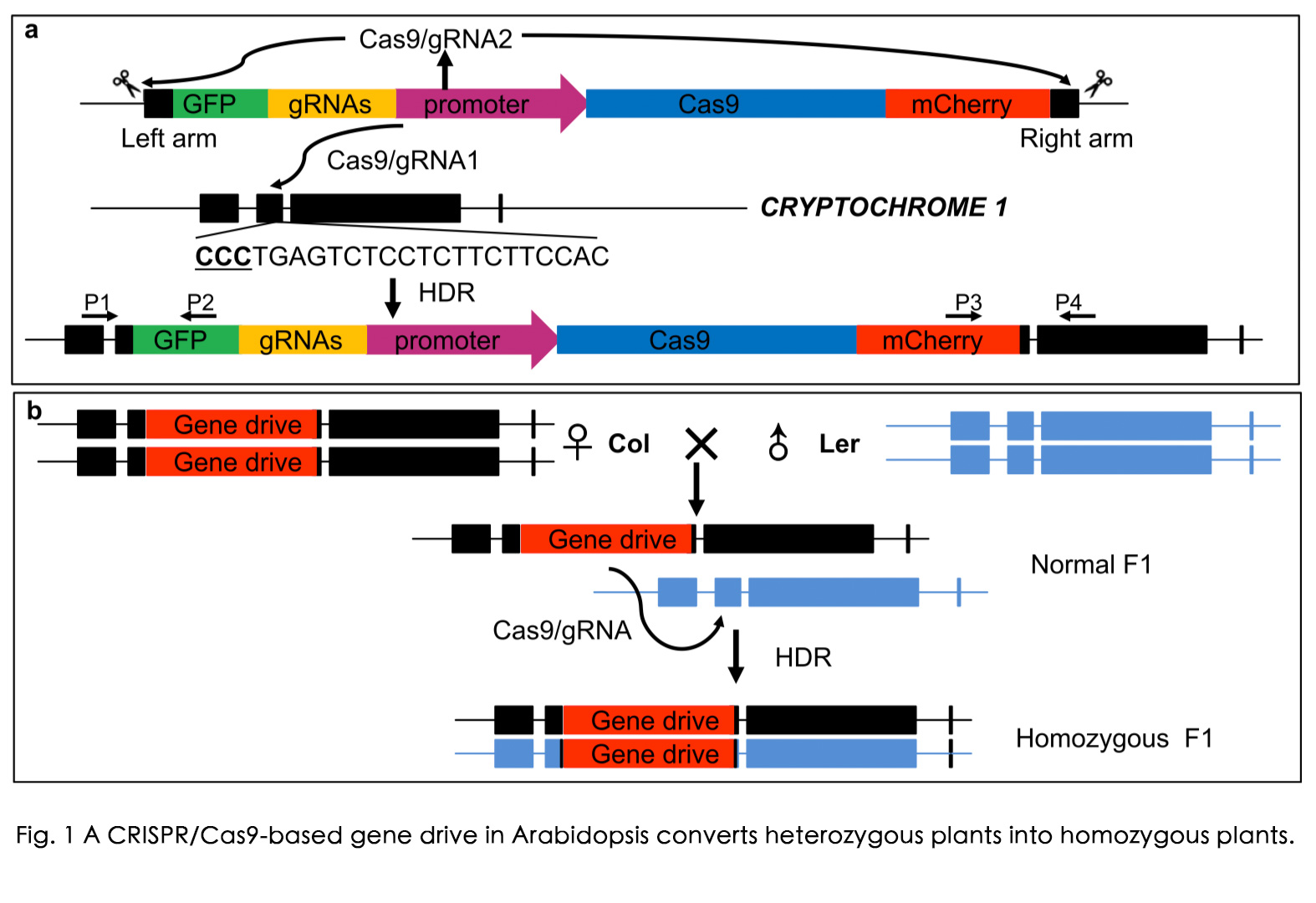博文
Nature Communications:CRISPR/Cas9介导的基因驱动帮助植物F1代即可获得靶位点纯合植株
||
Selective inheritance of target genes from only one parent of sexually reproduced F1 progeny in Arabidopsis
第一作者:Tao Zhang
第一单位:加利福尼亚大学
通讯作者:Yunde Zhao
Abstract
大背景:Sexual reproduction constrains progeny to inherit allelic genes from both parents. Selective acquisition of target genes from only one parent in the F1 generation of plants has many potential applications including the elimination of undesired alleles and acceleration of trait stacking. 小背景+问题:CRISPR/Cas9-based gene drives can generate biased transmission of a preferred allele and convert heterozygotes to homozygotes in insects and mice, but similar strategies have not been implementable in plants because of a lack of efficient homology-directed repair (HDR). 结果1-构建基因驱动:Here, we place a gene drive, which consists of cassettes that produce Cas9, guide RNAs (gRNA), and fluorescent markers, into the CRYPTOCHROME 1 (CRY1) gene through CRISPR/Cas9-mediated HDR, resulting in cry1drive lines. 结果2-F1代纯合:After crossing the cry1drive/cry1drive lines to wild type, we observe F1 plants which have DNA at the CRY1 locus from only the cry1drive/cry1drive parent. 结果3-非自主性反式基因驱动:Moreover, a non-autonomous trans-acting gene drive, in which the gene drive unit and the target gene are located on different chromosomes, converts a heterozygous mutation in the target gene to homozygous. 结论:Our results demonstrate that homozygous F1 plants can be obtained through zygotic conversion using a CRISPR/Cas9-based gene drive. 摘 要 
有性生殖限制了子代,必须从双亲中各自继承一个等位基因。在植物F1代中,仅从单个亲本中选择性获得目标基因具有许多潜在的应用,包括消除劣势等位基因和加速性状聚合。基于CRISPR/Cas9的基因驱动在昆虫和老鼠中,能够产生优势等位基因的偏向性传递,并且将杂合子转变为纯合子;但是,由于植物缺少高效的同源指导修复HDR,相关研究还未见报道。本文中,作者通过CRISPR/Cas9介导的HDR,将一段包含能够产生Cas9、gRNA和荧光标记的基因盒置入了CRY1基因区,形成了cry1drive株系。接着,作者通过杂交cry1drive/cry1drive株系和WT野生型,作者发现F1代中存在CRY1位点只来自于一方亲本,即cry1drive/cry1drive株系的个体。此外,作者还构建了一个非自主性反式作用基因驱动,即基因驱动单元与目标基因分散在不同的染色体上,结果发现成功将目标基因的杂合突变转变成了纯合突变。本文的研究揭示了,CRISPR/Cas9介导的基因驱动可以通过合子转化,获得F1代纯合。
通讯作者
** Yunde Zhao **
个人简介: 密歇根大学,博士; Salk研究所,博后。 研究方向:1. 生长素的生物合成及其调控;2. 生长素在腋生分生组织发育和植物器官发生中的作用。
doi: https://doi.org/10.1038/s41467-021-24195-5
Journal: Nature Communications
Published online: June 22, 2021
https://blog.sciencenet.cn/blog-3158122-1292541.html
上一篇:eLife:拟南芥胚珠原基的几何特征引导孢子母细胞的命运决定
下一篇:Plant Biotechnol J:基于CRISPR-Cas9技术研究杂交杨CES1和CES2在木质素合成中的功能
全部作者的其他最新博文
- • Plant Physiology:CsMADS3促进柑果中的叶绿素降解和类胡萝卜素合成(华中农业大学)
- • Molecular Plant:LBD11-ROS反馈调节作用于拟南芥的维管形成层增殖和次生生长(浦项科技大学)
- • Science Advances:根结线虫通过调控植物的CLE3-CLV1模块,促进侵染进程(日本熊本大学)
- • Nature Communications:油菜素内酯参与植物营养生长期转变的分子机制解析(浙江农林大学)
- • Current Biology:光合作用产生的蔗糖驱动侧根“生物钟”(德国弗莱堡大学)
- • PNAS:花同源异型基因在叶中被抑制、花中被激活的分子机制(南卡罗来纳大学)